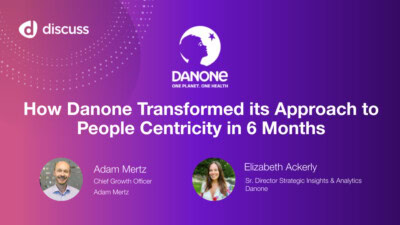A Guide for Qualitative Research Platform Selection

Insights for Selecting the Right Vendor to Drive Your Research Initiatives
In the realm of market research, the choice of a research platform plays a pivotal role in both qualitative and quantitative research speed, quality and spend. While the focus of this blog is on qualitative research, it’s important to recognize that selecting the right vendor is critical regardless of the research approach. With an array of options available, businesses often find themselves wondering: What should I be looking for in a qualitative research platform? In this blog, we delve into essential considerations derived from industry insights and survey data to guide researchers through the vendor selection process, illuminating the impact and benefits of each aspect on research endeavors.
In March of 2024, Discuss, the premier purpose-built platform for innovation driving next gen insights, conducted a comprehensive survey of research professionals, spanning both in-house teams and market research agencies. This diverse pool of participants included individuals with job titles ranging from moderators and researchers to executives and project managers. The survey gathered responses addressing methodologies, activities, and the significance of particular research platform features. These insights were instrumental in shaping Discuss’ strategy to enhance support for researchers effectively through their qualitative research platform.
Understanding Organizational Needs
Before embarking on the vendor selection journey, researchers must introspect and identify their organizational needs and objectives. Whether part of an in-house team or an agency, aligning the choice of a research platform with strategic initiatives is crucial. Data from the survey mentioned above suggests that for in-house teams, the need to adopt qualitative research technology and scale research globally were predominant drivers. While agencies emphasized the desire to enhance client deliverables and streamline research coordination. By clarifying these needs, researchers can tailor their vendor selection criteria to maximize relevance and effectiveness.
Simplifying Complexity: Consolidating Tools
One of the most pressing challenges faced by researchers today, whether agency professionals or those conducting research in-house at global brands, is the proliferation of tools and platforms for qualitative research. The survey data from Discuss unveils a complex tool landscape, with 66% of respondents indicating that they use between 3 and more than 6 tools for their research activities. This complexity not only hampers efficiency but also poses challenges in data management and analysis. Therefore, a critical consideration in vendor selection is the platform’s ability to consolidate research tools, streamline workflows, and enhance collaboration. By opting for an all-in-one platform, researchers can mitigate complexity, optimize resource utilization, and foster seamless integration across research activities.
Read more about the Top 4 Must-Haves of an All-in-One Qualitative Research Platform here.
In light of this complexity, let’s explore the top qualitative research platform features and their importance in the vendor selection process. Here, we’ll review the importance and impacts of each feature to help researchers make informed decisions when selecting a qualitative research vendor.
Qualitative Research Platforms: What to Consider in Selecting a Vendor
1. Overall Ease of Use
Importance: An intuitive and user-friendly interface is key for enhancing productivity and user satisfaction for all platform users. In meeting the needs of the following diverse set of users, the platform should ensure efficiency and satisfaction to maximize speed to insights while improving the quality of those insights and empathy for key target audiences.
For observers, it’s crucial to provide an effortless means to view conversations without the necessity of creating accounts, ensuring they can access sessions in a click and easily save key moments as they hear them.
Recruiters require visibility of all recruits and an easy process to send invites out to respondents, moderators, and observers, streamlining their workflow. Scheduling and coordinating research activities enable recruiters to manage timelines, resources, and respondent engagement effectively.
Moderators, on the other hand, rely on features like easy loading of stimuli, simple access to backroom conversations and discussion guides, and the ability to save key moments in a click while staying in the flow of the interview.
Project managers and analysts seek a platform that facilitates swift access to insights and final reports, enabling seamless sharing with key stakeholders.
Considerations: Platforms with clear navigation, well-designed layouts, and intuitive workflows enable researchers to focus on their core tasks without being bogged down by complex interfaces. A user-friendly platform promotes efficiency, reduces learning curves, and enhances overall research effectiveness. Its important to prioritize a platform that offers a robust suite of tools to streamline research activities for all users, from moderators to recruiters.
2. Insights and Analysis
Importance: The ability to generate actionable insights and communicate findings effectively is essential for driving informed decision-making. Insights and reporting capabilities enable researchers to distill complex data into meaningful narratives and actionable recommendations.
Considerations: When evaluating platforms for insights and reporting capabilities, it’s crucial to prioritize features that facilitate the extraction and communication of actionable insights effectively. Advanced reporting tools, customizable dashboards, and data visualization capabilities are indispensable in distilling complex data into meaningful narratives for stakeholders.
Moreover, platforms offering tools for discovering, extracting, and sharing critical insights from customer conversations can significantly enhance research effectiveness. For instance, features like auto-generating clips based on keyword tags, theme finders, and sentiment analysis leverage AI-driven technologies to streamline the process of extracting insights. Additionally, automatic transcription using Natural Language Processing (NLP) expedites the transcription process, enabling researchers to access valuable data quickly. Incorporating these tools not only enhances research efficiency but also maximizes the impact of research findings through shareable highlight reels or sizzle reels tailored for stakeholders or clients.
3. GenAI Capabilities
Importance: GenAI-driven insights hold immense potential in augmenting qualitative research processes and outcomes. GenAI capabilities enable researchers to uncover hidden patterns, extract meaningful insights, and derive actionable recommendations from large volumes of qualitative data. By automating labor-intensive tasks, such as extracting key themes or creating reports, GenAI allows researchers to focus more of their time and energy on extracting actionable insights and driving innovation in their research methodologies.
Considerations: When evaluating qualitative research platforms, one should consider whether it offers GenAI capabilities that support research on a global scale. Many platforms claim to provide “the latest” GenAI tools, but few truly offer GenAI tools capable of synthesizing insights across multiple languages. The ideal platform should enable researchers to conduct studies worldwide in various languages, facilitating comprehension of key themes even across interviews conducted in different languages. The GenAI should be designed to incorporate and synthesize not only English interviews but also those conducted in other languages. Furthermore, it should be capable of translating these multi-language interviews into English summaries, allowing for comparisons of research findings across regions and providing a broader global perspective on consumer insights.
4. Engaging in Live Virtual Conversations
Importance: Virtual engagement capabilities are essential for conducting live research activities such as focus groups, interviews, and brainstorming sessions. Live virtual conversations enable researchers to engage participants in real-time, fostering dynamic interactions and rich data collection experiences.
Considerations: When selecting a platform, prioritize features that streamline live virtual conversations, allowing researchers to connect with participants effortlessly. Look for tools that enable quick research set-up, saving valuable time on logistics and administrative tasks. An effective platform should offer capabilities to schedule and coordinate sessions, manage respondents, and keep track of consent forms or pre-work, all within one central hub.
Additionally, seek a qualitative research platform that enhance virtual engagement and data collection efficiency with features like dedicated observer backrooms, integrated discussion guides, interactive stimuli sharing, auto-clipping, and live polling and analysis, all designed to enable global conversations.
Furthermore, platforms equipped with GenAI-powered insights tools, such as built-in transcripts and auto-clipping, empower researchers to compile and deliver insights in record time, minimizing the need for extensive manual analysis. Lastly, consider scalability in research endeavors by choosing platforms that facilitate collaboration and sharing of customer voices across roles and teams. Collaborative features like dedicated observer backrooms, editable clips, custom highlight reels, and a range of additional tools including discussion guide writing, project management, translation services, and live tech support, ensuring seamless scalability and efficient research execution.
5. Conducting Asynchronous Activities
Importance: Asynchronous activities such as unboxing, shop-alongs, in-home usage tests, and diaries offer flexibility and convenience for both researchers and participants. Conducting asynchronous activities enables researchers to capture insights from participants over an extended period, without the constraints of time or location.
Considerations: Seek platforms that support asynchronous activities effectively, offering tools like discussion boards, survey functionalities, and mobile diary apps. Look for features that maximize engagement, such as asynchronous video feedback, unmoderated usability testing, and video open-ends.
Additionally, consider a qualitative research platform that provides access to high-quality respondents globally, enabling research activities like consumer closeness, in-home usage testing, and shop-alongs across borders. Platforms should offer seamless integration of both asynchronous and live qualitative methods, allowing researchers to maximize insights before or after live conversations and to dig deeper with both async and live feedback. Finally, prioritize platforms with tools for translating multi-language feedback, capturing sentiment and themes, and creating highlight reels for easy sharing and decision-making.
6. Qualitative Research Repository
Importance: Centralized storage and accessibility of research data are vital for promoting collaboration and knowledge sharing among research teams. A qualitative research repository acts as a centralized hub for storing, organizing, and retrieving research data, enabling researchers to harness insights from previous studies.
Considerations: Look for platforms that offer robust features for organizing and categorizing data within the repository. This includes seamless integration with various file storage systems like Dropbox, Google Drive, or SharePoint, allowing team members worldwide to upload and access video files easily. The platform should auto-transcribe these files, making them globally accessible and searchable. Additionally, prioritize platforms that sync with diverse tech stacks to streamline access to relevant information and facilitate data integration. By centralizing data storage and management, the platform should enhance collaboration and ensure insights are readily available across teams and departments, democratizing knowledge and ensuring its longevity. Integration with other business tools further enhances the utility, providing a seamless workflow for analyzing data, generating reports, and making data-driven recommendations, ultimately enabling market researchers to meet all business objectives within a single, multifunctional platform.
7. Integrations
Importance: Seamless integration with existing systems and tools is essential for maximizing efficiency and productivity in the research process. Integrations enable researchers to leverage complementary tools and functionalities, streamlining workflows and minimizing disruptions.
Considerations: Platforms that offer seamless integrations with popular research tools, communities, quantitative survey tools, panels and project management platforms enhance workflow efficiency and productivity. Features such as API integrations, single sign-on capabilities, and data syncing mechanisms enable researchers to leverage the full potential of their existing tool ecosystem, driving research effectiveness and innovation.
8. Security
Importance: Within the qualitative market research industry, safeguarding sensitive research data and ensuring compliance with international data protection laws are paramount. Security measures protect against unauthorized access, data breaches, and other security threats, fostering trust among researchers and participants.
Considerations: When selecting a platform for qualitative research, it’s essential to prioritize vendors that uphold stringent data security and privacy standards. Look for features such as robust data encryption, access controls, and compliance certifications to safeguard sensitive information.
Additionally, within the context of qualitative market research, verifying that platforms employ a closed-loop system when utilizing GenAI is critical. This system ensures that data sent for processing remains secure and inaccessible to unauthorized entities, maintaining the confidentiality of research data. While assessing security measures, it’s recommended to review the qualitative research platform’s adherence to industry best practices and standards. For comprehensive insights into a platform’s security protocols, explore resources such as the platform’s security and data privacy policies. By conducting thorough due diligence on security features and certifications, researchers can confidently select a qual research platform that prioritizes data security and compliance, fostering trust and confidence among stakeholders in the qualitative market research industry.
Empowering Research Excellence
In conclusion, the vendor selection process for a qualitative market research platform is a strategic endeavor that requires careful consideration of various platform features and their impact on research outcomes. By prioritizing features such as overall ease of use, GenAI capabilities, insights reporting, live, asynchronous, and off platform activities, and more, researchers can unlock the full potential of their initiatives. In navigating this process, it is essential to choose a platform that aligns with the organizational needs and objectives to empower innovative research and drive gen insights.
At Discuss, we understand the complexities and challenges of market research, which is why we’ve designed a purpose-built qualitative research platform that does it all. From research setup to conducting live and asynchronous research, collecting feedback, generating insights and reports, and serving as a comprehensive research repository, Discuss offers a seamless and integrated solution for all your research needs. With Genie, our GenAI Assistant, we streamline workflows, automate labor-intensive tasks, and extract key themes, insights, summaries, and quotes, empowering researchers to focus on what matters most – uncovering valuable insights. Built by researchers, for researchers, Discuss is your partner in driving research excellence and innovation.
Ready to unlock human-centric market insights?
Related Articles

Unifying Insights With A Qualitative Research Repository
Explore the benefits of integrating live interviews, asynchronous activities, and off-platform research into a centralized qualitative research repository for streamlined…
Explore the benefits of integrating live interviews, asynchronous activities, and off-platform research into a centralized qualitative research repository for streamlined…

Top 4 Must-Haves of an All-in-One Qualitative Research Platform
Get human-centric insights at scale with a purpose-built qualitative research platform Let’s be honest—running qualitative research today can feel like…
Get human-centric insights at scale with a purpose-built qualitative research platform Let’s be honest—running qualitative research today can feel like…

Overview of Top Qualitative Research Tools for Beginners
Qualitative research might sound a bit intimidating at first, but it’s really about understanding people in a deeper way. Picture…
Qualitative research might sound a bit intimidating at first, but it’s really about understanding people in a deeper way. Picture…



